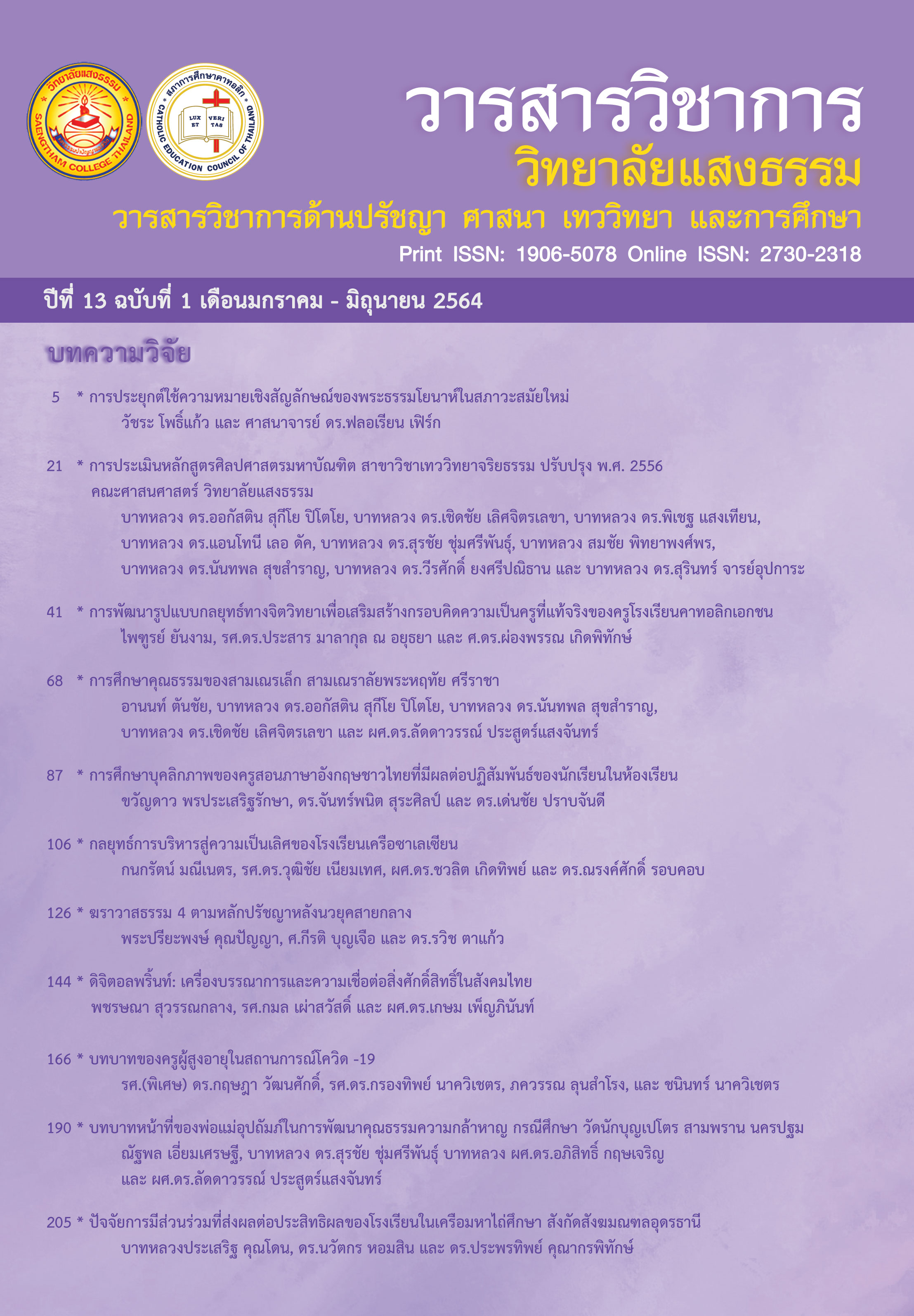กลยุทธ์การบริหารสู่ความเป็นเลิศของโรงเรียน เครือซาเลเซียน
Main Article Content
บทคัดย่อ
การวิจัยครั้งนี้มีวัตถุประสงค์เพื่อศึกษากลยุทธ์การบริหารสู่ความเป็นเลิศของโรงเรียนในเครือซาเลเซียน วิจัยครั้งนี้ใช้กลุ่มตัวอย่างจำนวน 248 คน ประกอบด้วย ผู้อำนวยการ หัวหน้าวิชาการ หัวหน้ากลุ่มสาระการเรียนรู้ ครูผู้สอน ประธานคณะกรรมการสถานศึกษา และผู้ปกครองจากโรงเรียนในเครือซาเลเซียน จำนวน 5 โรงเรียน มีขั้นตอนการดำเนินการ คือ 1) กำหนดความเป็นเลิศของโรงเรียนในเครือซาเลเซียน 2) ศึกษาสภาพปัจจุบันและสภาพที่พึงประสงค์และวิเคราะห์จุดแข็ง จุดอ่อน โอกาสและภาวะคุกคามของการบริหารสู่ความเป็นเลิศของโรงเรียนในเครือซาเลเซียน 3) ร่างกลยุทธ์ และตรวจสอบความถูกต้องและครอบคลุมเนื้อหาความเหมาะสม ความเป็นไปได้และประโยชน์ของกลยุทธ์การบริหารสู่ความเป็นเลิศของโรงเรียนในเครือซาเลเซียน และ 4) นำเสนอกลยุทธ์การบริหารสู่ความเป็นเลิศของโรงเรียนในเครือซาเลเซียนในการ เครื่องมือที่ใช้ในการเก็บรวบรวมข้อมูลเป็นแบบสอบถามและแบบประเมิน มีการวิเคราะห์ข้อมูลด้วยค่าเฉลี่ย ส่วนเบี่ยงเบนมาตรฐาน และค่าดัชนี PNImodified จัดทำสนทนากลุ่มกับผู้เชี่ยวชาญและผู้ทรงคุณวุฒิจำนวน 12 ท่าน วิเคราะห์การสนทนากลุ่มโดยใช้การวิเคราะห์เนื้อหา (Content Analysis) เพื่อยืนยันกลยุทธ์ ผลการวิจัย พบว่า กลยุทธ์การบริหารสู่ความเป็นเลิศของโรงเรียนเครือซาเลเซียน มี 8 กลยุทธ์ ประกอบด้วย 1) พัฒนาระบบบริหารการตลาด 2) พัฒนาแพลตฟอร์มเทคโนโลยีและสารสนเทศ 3) พัฒนาระบบบริหารจัดการข้อมูลและองค์ความรู้ 4) พัฒนาระบบบริหารความเสี่ยง 5) พัฒนาครูเจ้าหน้าที่ นักเรียน และผู้บริหารในการตัดสินใจบนฐานข้อมูลเชิงยุทธศาสตร์ 6) พัฒนาองค์กร วัฒนธรรมและสภาพแวดล้อม 7) พัฒนาระบบสรรหาและรักษาบุคลากรผู้มุ่งมั่นและมีสมรรถนะ และ 8) พัฒนาระบบค่าตอบแทนเชิงยุทธศาสตร์
Article Details
- บทความที่ได้รับการตีพิมพ์ในวารสารวิชาการ วิทยาลัยแสงธรรม ถือเป็นกรรมสิทธิ์ของวิทยาลัยแสงธรรม ห้ามนำข้อความทั้งหมดไปตีพิมพ์ซ้ำ ยกเว้นได้รับอนุญาตจากวิทยาลัยแสงธรรม
- เนื้อหาและข้อคิดเห็นใดๆ ที่ตีพิมพ์ในวารสารวิชาการ วิทยาลัยแสงธรรม ถือเป็นความรับผิดชอบของผู้เขียนเท่านั้น
เอกสารอ้างอิง
กระทรวงศึกษาธิการ. (2553). พระราชบัญญัติการศึกษาแห่งชาติ. พ.ศ. 2542 และที่แก้ไขเพิ่มเติม (ฉบับที่ 3) พ.ศ. 2553. กรุงเทพฯ: โรงพิมพ์คุรุสภาลาดพร้าว.
กระทรวงศึกษาธิการ. (2553). หลักสูตรแกนกลางการศึกษาขั้นพื้นฐานพุทธศักราช 2551. พิมพ์ครั้งที่ 3. กรุงเทพฯ: โรงพิมพ์ชุมนุมสหกรณ์การเกษตรแห่งประเทศไทยจำกัด.
กระทรวงศึกษาธิการ. (2556). คู่มือการจัดวางระบบการควบคุมภายในและประเมินผล. กรุงเทพฯ: กลุ่มตรวจสอบภายในระดับกระทรวงศึกษาธิการ สำนักงานปลัดกระทรวงศึกษาธิการ.
กองนโยบายและแผน. (2561). แผนกลยุทธ์มหาวิทยาลัยสวนดุสิต 2561 – 2564 ฉบับสมบูรณ์. กรุงเทพฯ: สำนักมหาวิทยาลัย มหาวิทยาลัยสวนดุสิต.
ชัชฎาภรณ์ อร่ามรุณ. (2556). กลยุทธ์การบริหารงานวิชาการในสถานศึกษาขั้นพื้นฐาน สังกัดสำนักงานเขตพื้นที่การศึกษาประถมศึกษากำแพงเพชร เขต 1 และเขต 2. วารสารศึกษาศาสตร์ มหาวิทยาลัยนเรศวร. 15(4), 45-54.
ประคัลภ์ ปัณฑพลังกูร. (2556, 5 สิงหาคม). กลยุทธ์การรักษาไว้ซึ่งพนักงาน. [ออนไลน์]. สืบค้นจาก: https://www.prakal.wordpress.com/2013/08/05/. (วันที่ค้นข้อมูล : 14 มกราคม 2562).
ปวันรัตน์ ชันษาและกัญญ์รัชการย์ นิลวรรณ. (2560). การพัฒนาการจัดระบบสารสนเทศเพื่อการบริหารกิจการนักเรียนในสถานศึกษาขั้นพื้นฐาน สังกัดสำนักงานเขตพื้นที่การศึกษาประถมศึกษาปทุมธานี เขต 2. วารสารวิชาการบัณฑิตวิทยาลัยสวนดุสิต. 13(3), 250-259.
พกานต์ ตันติกรพรรณและศศิวิมล สุขบท. (2561). องค์ประกอบการจัดการเชิงการตลาดของสถานศึกษาอาชีวะเอกชนเพื่อลดการขาดแคลนแรงงานภาคอุตสาหกรรม เขตภาคใต้ประเทศไทย. วารสารวิทยบริการ มหาวิทยาลัยสงขลานครินทร์. 29(1), 66-77.
พงศ์ศรันย์ พลศรีเลิศ. (2555, 8 มกราคม). การสร้างความเข้มแข็งองค์กรด้วยหลัก 3 C. [ออนไลน์]. สืบค้นจาก: https://www.phongzahrun.wordpress.com/2012/01/18. วันที่ค้นข้อมูล : 18 มกราคม 2562.
โรงเรียนดอนบอสโกวิทยา. (2560). รายงานการประเมินตนเอง ระดับปฐมวัย.
ราตรี ศรีไพรวรรณ และ พฤทธิ์ ศิริบรรณพิทักษ์. (2561). การพัฒนากลยุทธ์การบริหารสู่ความเป็นเลิศของโรงเรียนมาตรฐานสากล ระดับประถมศึกษา. วารสารวิชาการมหาวิทยาลัยอิสเทิร์นเอเชีย. 3(2), 182-194.
สถาบันเพิ่มผลผลิตแห่งชาติ. (2558). เกณฑ์รางวัลคุณภาพแห่งชาติ. กรุงเทพฯ: โรงพิมพ์ตะวันออกจำกัด
สิรินาถ ปัทมาวิไล. (2557, 29 มิถุนายน). กลยุทธ์การบริหารจัดการสถานศึกษาสู่ความสำเร็จ. [ออนไลน์]. สืบค้นจาก http://www.pattamawilai.blogspot.com/. วันที่ค้นข้อมูล: 31 มกราคม 2562.
สุวิมล ว่องวาณิช. (2552). การวิจัยประเมินความต้องการจำเป็น. กรุงเทพฯ: สำนักพิมพ์แห่งจุฬาลงกรณ์มหาวิทยาลัย.
สำนักงานคณะกรรมการการอุดมศึกษา. (2559, 1 เมษายน). เกณฑ์คุณภาพการศึกษาเพื่อการดำเนินการที่เป็นเลิศ ฉบับปี 2558-2561. [ออนไลน์]. สืบค้นจาก : http://www.edpex. rg/2016/04/edpexcriteria58-61.html. วันที่ค้นข้อมูล : 2 กุมภาพันธ์ 2562.
อัษฎางค์ ดุษฎีอิสริยวงศ์. (2550). วิธีการอบรมของคุณพ่อบอสโก. พิมพ์ครั้งที่1. กรุงเทพฯ: คณะซาเลเซียนแห่งประเทศไทย.
อภิวัฒน์ กันศรีเวียง. (2556). กลยุทธ์การพัฒนาระบบบริหารจัดการข้อมูลสารสนเทศของสำนักงานเขตพื้นที่การศึกษามัธยมศึกษา. วารสารบริหารการศึกษามหาวิทยาลัยศรีนครินทรวิโรฒ. 10(19), 33-44.
Krejcie, R. V. & Morgan, D. W. (1970). Determining Sample size for Research Activities. Education and Psychological Measurement. 30(3), pp.607-610.
Law, M., Stewart, D., Letts, L., Pollock, N., Bosch, J., & Westmorland, M. (1998). Guidelines from Critical review form-Qualitative studies. [Online]. Retrieved from : http://fhs.mcmaster.ca/rehab/ebp/pdf/qualguide-lines.pdf. Access date : March 1, 2019.
Lovelock, C. H., & Wright, L. K. (1999). Principles of Service Marketing and Management. New Jersey: Prentice Hall.
OECD. (2015). Students computers and learning. [Online]. Retrieved from : http://www.oecd.org/publications/students-computers-and-learning. Access date: March 1, 2019.


